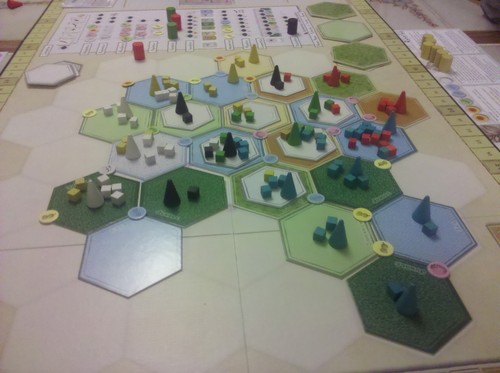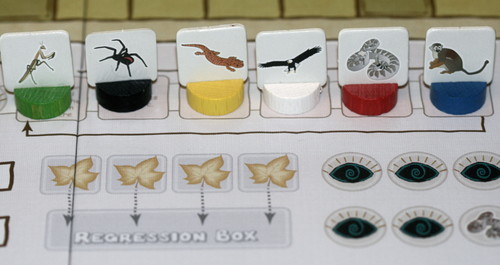GMT is known for war games but recently they have produced a few games which are definitely not war games. After Leaping Lemmings (which probably deserves its own entry someday) they released Dominant Species which catapults GMT heavily into the eurogame realm. The designer of the game, Chad Jensen, has designed the popular Combat Commander: Europe series which is lightish in war game standards but definitely a war game nonetheless and now he is into thematic eurogames with Dominant Species.

Thematic is a word which describes Dominant Species well. As you might guess the game is about evolution especially about the race to survive from the coming Ice Age. Players represent one species (like amphibians, birds or mammals) and set out to spread their species on the growing earth which is formed with terrain tiles. Basic flow of the game is this:
- players place their action pawns on the board
- players execute the corresponding actions in order
- bookkeeping and reset the board
This is continued until the Ice Age card is taken from the board. There’s 25 cards and 5 of them may be taken during a round which means that the game lasts minimum 5 rounds (Ice Age cards is always the last card of the draw deck) and 5 rounds leads to a long playing time (3-4 hours with four players).

Dominant Species has to main mechanics; firstly it’s a worker placement game and secondly it’s a area majority/control game. Worker placement part of the game is important since there are 12 different actions one can choose from. This leads directly to a serious problem which can occur with Dominant Species – Analysis Paralysis. There are players who should avoid this game simply because it will make their head explode and/or they get beaten up by the frustrated game mates.
While worker placement is important in Dominant Species I still think that it’s more of an area majority game. Most of the points in the game come through the scoring of terrain tiles and this is done by counting the species (cubes) on that particular tile. Whoever has most cubes gets the maximum amount of points, second gets less and so on. The interesting, thematic, and in the beginning, confusing part of the game is that the player who has the most cubes on a tile does not automatically as dominance on that tile.

Dominance comes through the elements (grass, grub, meat, seed, sun and water) which surround the tile and the element which your species has on its player board and obviously dominance is continuously changing factor in the game. You need dominance to activate the cards (during the scoring of a terrain tile) which are very powerful and can destroy your position in worst case thus creating a situation in which you have to fight for both the majority and dominance of different areas.
As you can see there’s a lot going on here and at first it seems that Dominant Species is a complex game but it repeats itself so much that it becomes a lot easier quickly. Game is very rich in theme and mechanically solid which is why I like it but it’s not the best game of this decade like Tom Vasel states in his video presentation of the game and here’s why:
Dominant Species takes too long to play and there’s a tad too powerful cards in the game which increase the randomness of the game significantly. These two negative factors have a lot of positive counter elements like superb components, thematic game play and a lot of interaction but long games limit the opportunities to play the game and powerful cards can kill the game for some of the players.
With the right group and if you have an 2-4 hour slot to play a rich and thematic game you should really try give Dominant Species a try. If you are into typical 60-90 minutes eurogames, this game is probably not for you.